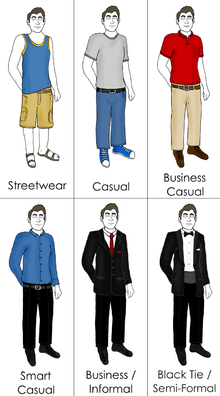Dress code
A dress code is a rule about what people should, must or mustn't wear. Many times these rules are obvious: they do not need to be written. For example, when walking around a city or going to work one needs to have appropriate clothes. These can change depending on different countries and cultures. At other times a dress code can be a written rule: this can happen for important events. Some private places might also have a dress code that people need to follow to be allowed in - for example churches and nightclubs. Many organizations require a uniform.

The way a person chooses their clothes can be very important in a social environment. Different types of clothes can give an idea of how much money a person has, what religion he follows, marital status, etc.
Western dress codes change
In the Western world, there are the following dress codes for important events. These can include, for example, State dinners (when important people of different countries meet over dinner), weddings or the Nobel Prize ceremony.
- Casual attire is a relaxed dress for more freedom. Examples of casual garments and accessories include t-shirts, shorts, jeans, baseball caps, most sunglasses
- Ceremonial dress or Court dress: this depends on the country and occasion
- Formal or White tie. Men have a black suit, a white shirt and a white bow tie. Women have a long dress; they can't wear trousers.
- Semi-formal or Black tie. It is similar to a white tie, but the suit is a bit different and the bow tie needs to be black.
- Informal or Business attire. Men have a simple business suit with a shirt of any colour and a tie. Women can wear a short dress or even a business suit if they like.